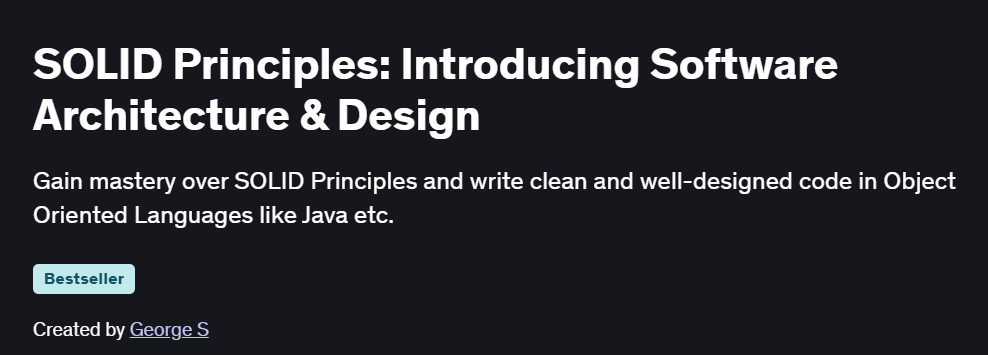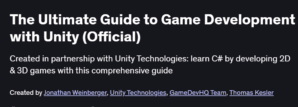What will you learn in SOLID Principles: Introducing Software Architecture & Design Course
Master the SOLID principles in object-oriented software design.
Learn how to write scalable, maintainable, and robust code.
Understand the architectural mindset behind clean code practices.
Apply key design principles to real-world software problems.
Program Overview
Module 1: Introduction to SOLID Principles
⏳ ~30 min
Topics: Importance of software architecture; benefits of clean code; evolution from procedural to object-oriented design.
Hands-on: Watch 5 intro videos and analyze a poorly designed system to set context.
Module 2: Single Responsibility Principle (SRP)
⏳ ~1 hour
Topics: The idea of one class, one job; breaking up responsibilities; real-world code smells.
Hands-on: Refactor a monolithic class into multiple cohesive units using SRP.
Module 3: Open/Closed Principle (OCP)
⏳ ~1 hour
Topics: Extend functionality without modifying existing code; abstract classes and interfaces; plug-and-play design.
Hands-on: Implement open/closed architecture in a payment gateway use case.
Module 4: Liskov Substitution Principle (LSP)
⏳ ~45 min
Topics: Ensuring subclasses substitute their parents safely; behavior contracts; avoiding inheritance misuse.
Hands-on: Break and then fix a class hierarchy to follow LSP in a vehicle example.
Module 5: Interface Segregation Principle (ISP)
⏳ ~40 min
Topics: Prefer many small interfaces; avoid “fat” contracts; flexible service interfaces.
Hands-on: Design cleaner APIs for client classes using ISP.
Module 6: Dependency Inversion Principle (DIP)
⏳ ~1 hour
Topics: High-level modules should not depend on low-level ones; invert control using abstractions.
Hands-on: Introduce dependency injection and apply DIP in a notification system.
Module 7: Final Architecture & Case Study
⏳ ~1 hour
Topics: Review SOLID principles; apply all five in a single end-to-end system; software engineering best practices.
Hands-on: Build a mini project that demonstrates all SOLID principles working together.
Get certificate
Job Outlook
High Demand for Design-Oriented Developers: As systems grow complex, companies seek developers who can design clean, maintainable architectures.
Career Advancement: Mastery of SOLID opens doors to software architect, tech lead, and senior developer roles.
Salary Potential: Software developers with design and architecture expertise earn $90,000–$140,000+ annually (US average).
Freelance Edge: Clean architecture is a selling point for freelancers building scalable apps or consulting on refactors.
Specification: SOLID Principles: Introducing Software Architecture & Design
|
FAQs
- Basic programming knowledge recommended but not mandatory.
- Covers object-oriented design and architectural best practices.
- Explains complex principles with real-world code examples.
- Teaches writing clean, maintainable, and scalable code.
- Suitable for developers aiming to improve code quality and architecture skills.
- Hands-on labs include refactoring monolithic classes and systems.
- Apply SRP, OCP, LSP, ISP, and DIP in real-world examples.
- Mini project demonstrates full SOLID architecture integration.
- Learn best practices for maintainable and scalable software.
- Reinforces theoretical concepts through practical coding exercises.
- Prepares for Software Developer, Software Engineer, and Tech Lead roles.
- Supports transition to Software Architect and senior development positions.
- Builds skills highly valued in professional and freelance projects.
- Knowledge of SOLID principles improves code maintainability and career competitiveness.
- Salary potential: $90,000–$140,000+ annually (US average).
- Mini project applies all five SOLID principles in one system.
- Module-based exercises allow incremental skill application.
- Provides practical coding examples for portfolio demonstration.
- Enhances real-world understanding of software architecture.
- Reinforces lessons through end-to-end software design practice.
- Total course duration is ~5–6 hours across seven modules.
- Modules include lectures, code demos, and hands-on exercises.
- Flexible pacing allows learners to study alongside other commitments.
- Labs and mini-projects may require extra practice time.
- Most learners complete it in 1 week with focused effort.





